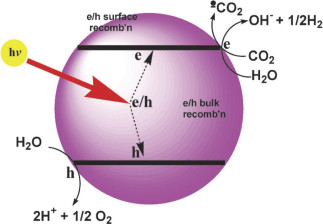Nick Serpone, University of Pavia, Dept. of Chemistry viale Taramelli, 12, 27100 Pavia, Italy
The two oil crises of the 1970s led to the search for renewable energy sources, with water splitting as the principal source of H2 subsequent to a short article by Fujishima and Honda (Nature, 1972) that started a frenzy research activity, which was to begin the Hydrogen Economy. The use of water as the source of a fuel was predicted nearly 140 years ago by Jules Verne (The Mysterious Island, 1874) and later implicitly stated by Giacomo Ciamician (1912). Unfortunately, the Hydrogen Economy never panned out. Though many strategies have been proposed and some experimented with, it became clear that a process occurring in heterogeneous media might achieve the desired results through the intermediacy of semiconductor-based photocatalysts. Studies of Heterogeneous Photocatalysis toward environmental remediation and in the generation of useful fuels from the reduction of H2O (to hydrogen) and CO2 (to methanol, CO, and/or methane) have been carried out largely in the last four decades, in which it was deduced that separation of the photogenerated charge carriers (electrons and holes) was an important critical component of any successful attempt at the destruction of pollutants and in the production of solar fuels. Although water splitting has been achieved in some cases, the quantity of H2 produced remains disappointingly low, even when a sacrificial electron donor (hole scavenger) is involved in the process. Results from the literature and from the patent literature (# of patents about 12-13% of the literature) will be presented. Quantitative data about the amount of hydrogen evolved or carbon-based fuels produced will be indicated whenever available. Even though results are disappointing, much has been learned in new nanomaterials. The Holy Grail photocatalysts to achieve significant water splitting and reduction of the Greenhouse gas, carbon dioxide, have yet to be found. Le café est servi à partir de 11h20.
Voici le lien vers la page web du groupe de recherche du Pr Serpone
Cette conférence est présentée par le RQMP Versant Nord du Département de physique de l'Université de Montréal et le Département de génie physique de Polytechnique Montréal.

